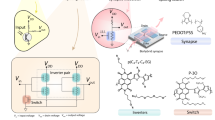Some superior technological secrets have come to light from a deep-sea organism.
Abstract
Modern technology cannot yet compete with some of the sophisticated optical systems possessed by biological organisms1,2,3. Here we show that the spicules of the deep-sea 'glass' sponge Euplectella have remarkable fibre-optical properties, which are surprisingly similar to those of commercial telecommunication fibres — except that the spicules themselves are formed under normal ambient conditions and have some technological advantages over man-made versions.
This is a preview of subscription content, access via your institution
Access options
Subscribe to this journal
Receive 51 print issues and online access
$199.00 per year
only $3.90 per issue
Buy this article
- Purchase on Springer Link
- Instant access to full article PDF
Prices may be subject to local taxes which are calculated during checkout

Similar content being viewed by others
References
Aizenberg, J., Tkachenko, A., Weiner, S., Addadi, L. & Hendler, G. Nature 412, 819–822 (2001).
McPhedran, R. C. et al. Aust. J. Chem. 54, 241–244 (2001).
Cattaneo-Vietti, R. et al. Nature 383, 397–398 (1996).
Perry, C. C. & Keeling-Tucker, T. J. Biol. Inorg. Chem. 5, 537–550 (2000).
Simpson, T. L. The Cell Biology of Sponges (Springer, New York, 1984).
Sarikaya, M. et al. J. Mater. Res. 16, 1420–1428 (2001).
Marcuse, D. Principles of Optical Fiber Measurements (Academic, New York, 1981).
Clegg, W. J., Kendall, K., Alford, N. M., Button, T. W. & Birchall, J. D. Nature 347, 455–457 (1990).
Kamat, S., Su, X., Ballarini, R. & Heuer, A. H. Nature 405, 1036–1040 (2000).
Cha, J. N., Stucky, G. D., Morse, D. E. & Deming, T. J. Nature 403, 289–292 (2000).
Kroger, N., Lorenz, S., Brunner, E. & Sumper, M. Science 298, 584–586 (2002).
Author information
Authors and Affiliations
Corresponding author
Ethics declarations
Competing interests
The authors declare no competing financial interests.
Rights and permissions
About this article
Cite this article
Sundar, V., Yablon, A., Grazul, J. et al. Fibre-optical features of a glass sponge. Nature 424, 899–900 (2003). https://doi.org/10.1038/424899a
Issue Date:
DOI: https://doi.org/10.1038/424899a
This article is cited by
-
Observations of coral and cryptobenthic sponge fluorescence and recruitment on autonomous reef monitoring structures (ARMS)
Coral Reefs (2022)
-
Biophotonic probes for bio-detection and imaging
Light: Science & Applications (2021)
-
Chain length of bioinspired polyamines affects size and condensation of monodisperse silica particles
Communications Chemistry (2021)
-
DNA nanostructures as templates for biomineralization
Nature Reviews Chemistry (2021)
-
Can sustainable, monodisperse, spherical silica be produced from biomolecules? A review
Applied Nanoscience (2021)
Comments
By submitting a comment you agree to abide by our Terms and Community Guidelines. If you find something abusive or that does not comply with our terms or guidelines please flag it as inappropriate.



